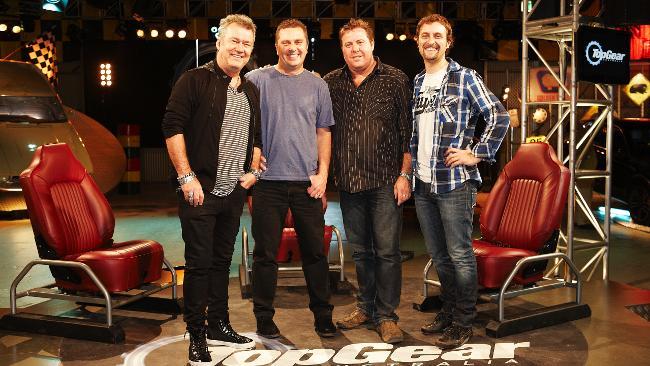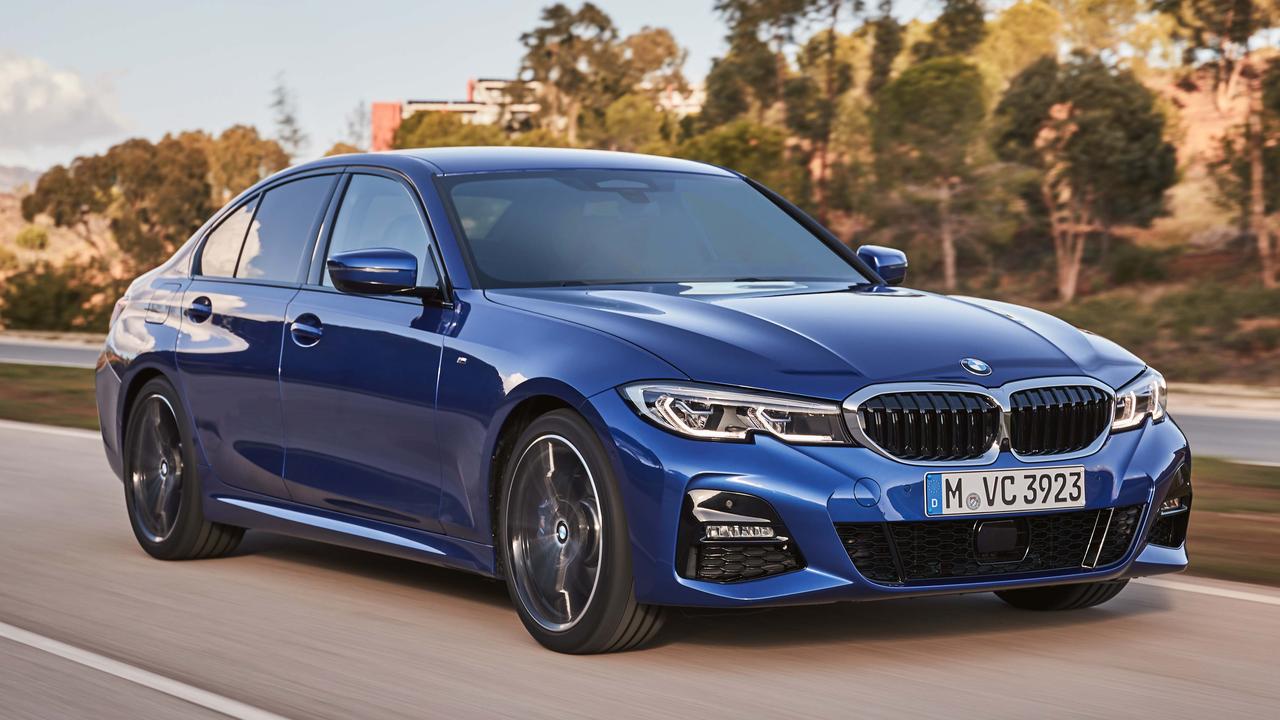Let's get this show on the road
Larrikins and fast cars can make for great TV - and Top Gear is just one in a crowded field.

THERE'S a secret farm somewhere in Britain where Stigs are being bred, The Sun newspaper revealed exclusively last month.
It ran a picture of them, in a variety of colourful racing suits and helmets, being rounded up so the Top Gear team could select a new one from the herd.
The wildly popular BBC motoring show, and its anonymous racing driver known only as the Stig, have been making headlines this year and frivolous tabloids haven’t been the only ones fascinated. After months of speculation that a professional racing driver, Ben Collins, was the face behind the dark visor, the BBC tried to stop publication of his tell-all book – and failed. That made news worldwide. Whoever the next recruit is, he’ll be forced to hide in the spotlight just like Collins.
The effort that went into unmasking the character is a measure of what Top Gear has become. Since the flagging show was relaunched in 2002 its presenters, led by the inimitable Jeremy Clarkson (whose weekly column appears in the print edition of The Australian), have become the acceptable faces of motoring for 500 million globally. Spin-offs, including an elaborate stage production that embarks on annual world tours, are legion. And lucrative. Few programs in any genre can match it.
Top Gear’s broad appeal, which crosses the gender divide and makes car fans of us all, has thrown down a driving glove to similar-minded shows. The way the franchise has struggled to expand shows how difficult its success is to replicate, even when everything from the titles to the gags are borrowed wholesale. A US version is about to debut after being on-again, off-again for years, with distributors worried that American audiences just wouldn’t get it. Locally, an Australian version struggled to retain half the viewers that SBS attracted with the UK show. After two seasons of falling ratings, this year it switched to Nine. With the commercial heavyweight behind it, the third series has drafted in two new presenters, including Shane Jacobson from the hit Aussie comedy film Kenny. Since its launch on September 28, when it was the second most watched program, Top Gear Australia looks like being a goldmine for Nine. But it still cannot match the wit and polish of the original.
In the UK, reject presenters from Top Gear went on to make rival show Fifth Gear, which was launched in 2002 and is one of the pioneers of the genre. The stunts are just as impressive and consumer advice more focused, although the segments are shorter and played less for laughs. The hosts are mainly pros, with Tiff Needell, Vicki Butler-Henderson and Jason Plato bringing top-level skills to the driving sequences. Last month, it was reported that Ben Collins will be joining them next season, presumably without The Stig’s trademark white racing suit. That means there’s lot to get revved up about even if Fifth Gear comes a distant second to Clarkson and co for pure entertainment.
If Top Gear has parked right outside the average semi, reality TV has burst open the enthusiast’s garage door. For every Trinny and Susannah prepared to redo your wardrobe, there’s been a street-smart dude offering to make-over your car on Pimp My Ride and its ilk. From the middle of last decade, there has been a profusion of niche offerings in the motoring genre exploiting the reality formats. For the past year, these have been coralled on Foxtel and Austar onto a dedicated pay TV channel, Discovery Turbo Max. It runs a constant schedule of shows, including Fifth Gear, that takes in the full range of fast machinery. Without the broad acceptability of food, fashion and real-estate content, this stuff is unashamedly pitched at the 18- to 54-year-old male.
One of the longest-running is Wheeler Dealers, from the UK, in which worn-out classics are given a second chance to look their best. In each episode the hosts have a modest budget to chase a target car with the goal of restoring it and then reselling at a profit.
Mark Brewer handles the dealing side and in the first episode of the next series, soon to screen on Turbo Max, he goes after the Lotus Elan, a landmark British sportscar. Forty years ago this was a fast car and despite a tiny engine it still is, thanks to its lightweight fibreglass construction. Brewer tracks a one-owner example down to the leafy suburbs and we watch them haggle. Despite a few problems emerging on a test drive, it’s in good nick and Brewer is delighted with the deal: “A Lotus Elan for eight-and-a-half grand [$13,600]! Wicked!” Then it’s back to the garage so that Edd China (really) can get it sorted. Despite being the spanner of the two, Edd has the posher accent and gently shines a light on the mechanical issues. Ball joints and drive shafts are replaced, and after a respray the smart cherry-and-white convertible looks to be worth a few weekends of shed solitary. You’ll come away thinking your own project is just a socket set away.
Given sufficient funds, your restored Elan could be a starter in one of the many classic events that draw wannabe Schumachers from all over the world – although, if GT Racer is anything to go by, it would be totally outclassed by the Ferraris and Jaguars, Aston Martins and Cobras that flock to compete. GT Racer is a fly-on-the-pitlane-wall look at the elite world of the European gentleman racer. No oily nails for them – men in overalls, with regional Pommie accents, see to all that. The cars look and sound gorgeous, despite their propensity to fall apart, and it’s impressive that anyone will risk bending such valuable metal.
If you’ve ever attended a similar gathering, such as a classic rally, you’ll be able to smell the unburnt fuel and the on-track, in-car footage is compelling. The show follows the tour to the Le Mans track in France and the famous Nürburgring in Germany, but individual episodes are over-long and you’ll pick the vanity production values from the opening soundtrack alone. At least the Le Mans movie had Steve McQueen.
There’s a perverse sort of vanity running through American Chopper, too, which has achieved some of Top Gear’s fame using fewer wheels but much more metallic paint. Chopper motorcycles are to transport what platform shoes are to footwear, and suggest the same blinkered approach to personal appearance that compels obese men to sport obsessively manicured facial hair.
After two decades and umpteen TV series getting on each other’s nerves, the fat hairy blokes with tats had a serious spat in the last series so the father-and-son team from Orange County have gone their separate ways. End of the road? No way. What better premise for American Chopper: Senior v Junior? You don’t need to like bikes to watch this, because it’s effectively a two-wheeled Dr Phil. Paul Jr takes to the local airwaves to mouth his grievances and Paul Sr answers back through his lawyers. We follow Paul Jr’s attempt to set up a rival shop while Dad gets on with the business of being bitter and making another cool bike. It’s impossible not to admire the craft, even if the finished bike has the artistic qualities of a chrome-plated tattoo.
Fascination with choppers also inspires Build or Bust, which gives apprentice builders a month in a garage to see whether they can construct a bike of their own design. The witless recruit is subject to ribbing of the so-you-think-you-can-weld variety, and the production values are as poor as the haircuts.
The big daddy of mainstream reality shows is Survivor, which pitches a bunch of Americans with perfect teeth into a deserted location to watch them crave cheeseburgers. We don’t see the contestants on Bullrun eat – although there’s clearly no danger they’ll starve – but this show could have been called Survivor: Driver. It’s billed as the toughest and most exciting road rally in the world, with 12 driver-navigator teams competing for a $US200,000 prize. They cover 6500km in 20 days, with indemnities and challenges along the way.
Combustive team chemistry is the key to making these sorts of shows interesting, and the new series has a suitably diverse range of contestants, from Asian-Americans in a Lamborghini to Texas hillbillies in a Mini. The yuppie couple in a Beemer need to win to keep up the repayments, and who could doubt their commitment when they say they’re ready to give 110 per cent? Of course, it’s not about speed per se, but the ability to successfully navigate in mirror shades and the total absence of electronic equipment. That’s what they used to call map reading, isn’t it? Luckily, quietly confident Team Lambo spices things up with a few dirty sign-changing tricks.
Some of the locations are good – there’s a showdown in a Mojave desert airplane graveyard – and Bullrun has a certain cheesy charm. With its pneumatic bikini babes and fondness for explosions, it takes you back to a land before political correctness and fuel shortages, where cookies were always crumbling and there were more clichés than you could shake a Stig at.


